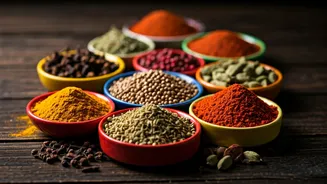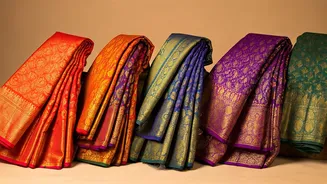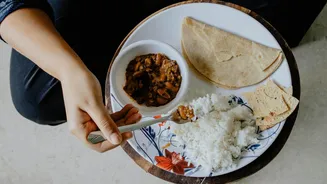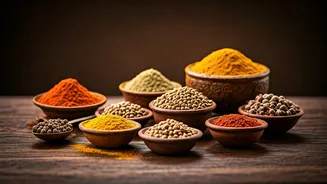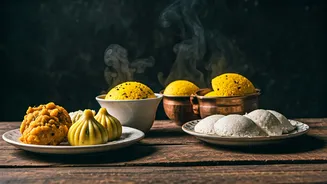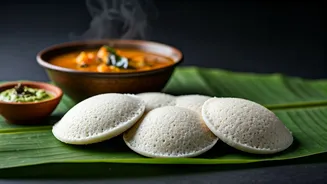A Land of Flavors
India's culinary heritage is a tapestry woven from diverse threads, reflecting the country's rich history and varied geography. The Indian subcontinent,
with its vast landscapes, climates, and cultures, has given rise to a stunning array of dishes, each reflecting the local ingredients, cooking styles, and traditions. The presence of both vegetarian and non-vegetarian cuisines is another feature. Spices, a defining element of Indian cooking, are not merely used for flavor; they are also valued for their medicinal properties. These spices, which are often freshly ground to release their full aroma and taste, are combined in various proportions to create the distinctive flavors of Indian food. This unique blend of ingredients, coupled with diverse cooking techniques, distinguishes Indian food as one of the most exciting and flavorful cuisines in the world.
Regional Delights Unveiled
The culinary map of India is a vibrant mosaic, with each region boasting its own signature dishes and methods of preparation. In the north, the influence of Mughal cuisine is evident in rich gravies, creamy curries, and the use of the tandoor. Dishes like butter chicken, biryani, and various types of kebabs are prominent. Moving towards the east, you find a focus on fish and rice, especially in Bengal, where the food is often characterized by subtle flavors and the use of mustard oil. In the west, Gujarati and Maharashtrian cuisines emphasize vegetarian dishes with sweet, sour, and spicy elements. Finally, the south showcases the use of rice, lentils, and coconut, and is renowned for its spicy curries, idlis, dosas, and a variety of chutneys. Each region's cuisine tells a story of its history, climate, and the available ingredients, offering a unique and delightful culinary experience.
Key Ingredients Explored
Central to the richness of Indian cooking are its ingredients, which are chosen based on their freshness, availability, and the specific requirements of each dish. Spices are undoubtedly the stars, with ingredients like turmeric, cumin, coriander, and cardamom adding color, aroma, and flavor. They are used in various forms: whole, ground, or as part of a spice mix known as garam masala. The use of pulses, especially lentils (dal) and chickpeas (chana), is common as a source of protein and in creating various dishes. Vegetables, ranging from potatoes to cauliflower, and leafy greens like spinach, are essential components in most meals. Dairy products, like yogurt and ghee, are used for richness and texture, adding depth to curries and other dishes. Rice, a staple in many regions, is available in different varieties, like long-grain basmati and short-grain rice, each suited to different preparations. The thoughtful selection and proper use of these ingredients are crucial for capturing the authentic essence of Indian cuisine.
Cooking Techniques Explained
Indian cooking involves several traditional techniques that have been passed down through generations. Sautéing, known as tadka, involves frying spices in hot oil to release their flavor and aroma, which is then added to a dish. Grinding spices, a manual process using a mortar and pestle, helps release flavors and control the consistency, which is vital for many dishes. Slow cooking is common, allowing flavors to meld and deepen over time, particularly for dishes with complex flavors. The tandoor, a cylindrical clay oven, is used for roasting meats and baking breads, giving them a smoky flavor. Steaming, often used for idlis and dhoklas, preserves the nutrients and textures of the ingredients. Frying, both shallow and deep, is a key method, imparting crispness and a rich flavor. The cooking methods are just as important as the ingredients, with each technique carefully chosen to elevate the flavors of a dish.
The Evolution of Flavors
Indian cuisine is not static; it has always been subject to evolution, absorbing influences from various cultures and adapting to changing tastes. The arrival of the Mughals introduced rich gravies, slow-cooked dishes, and the use of dry fruits and nuts. The Portuguese brought chillies, now a staple in Indian cooking. Over time, Indian cuisine has spread globally, inspiring chefs worldwide to create innovative fusions and adaptations. Modern Indian cuisine embraces this evolution, experimenting with new ingredients, techniques, and presentation styles. Restaurants are beginning to offer innovative takes on classic dishes, using modern cooking equipment, and adopting contemporary plating styles. The integration of global flavors with traditional techniques has led to the creation of dishes that appeal to a wide array of palates, ensuring that Indian cuisine continues to fascinate and evolve.
